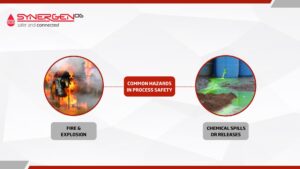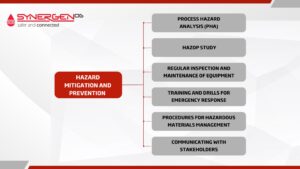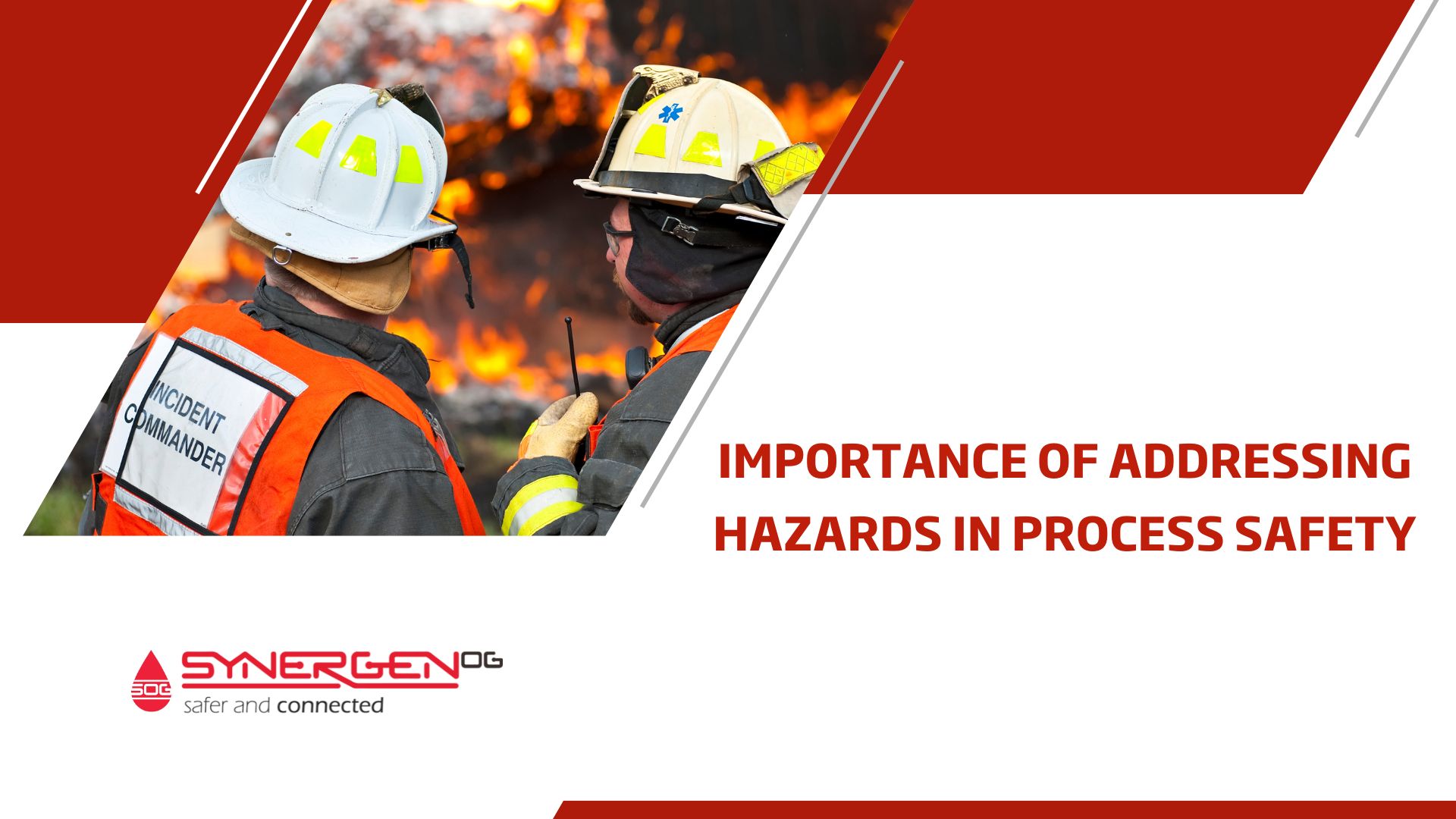Have you ever wondered what causes industrial accidents and what can be done to prevent them?
Process safety hazards are a critical aspect of industrial operations, as it involves the management of hazards that can lead to accidents, injuries, and even fatalities. To minimise risks, it is crucial to understand the various forms of hazards.
Here, we will explore the types of hazards that can occur in process safety and the steps that can be taken to prevent and mitigate them.
What are Hazards
Hazards are any potential source of harm or damage that can be encountered in the course of industrial operations. They can include physical hazards, such as explosions or fires, and chemical hazards, such as toxic spills or releases of hazardous materials.
Other hazards can include biological hazards, such as the spread of disease or infection, and ergonomic hazards, such as repetitive motion injuries.
Common Hazards in Process Safety

1) Fire and Explosions
Fire and explosions pose one of the most common hazards in process safety. They can occur due to a variety of causes, including equipment failure, human error, and natural disasters.
For example, a fire can occur due to a malfunctioning piece of equipment, while an explosion can be caused by a build-up of pressure or a release of flammable materials. Fire and explosions can lead to severe injuries and fatalities, and significant damage to equipment and infrastructure.
2) Chemical Spills or Releases
Chemical spills and releases can happen in a flash, and the results can be catastrophic. They may occur by a variety of factors, such as equipment failure, human error, or even natural disasters.
Imagine a chemical spill caused by a malfunctioning piece of machinery, or the release of toxic gases as a result of a human misstep in handling hazardous materials. It is possible for these kinds of hazards to result in major misshapes, fatalities, and environmental damage.
The Causes of Hazards
- Equipment failure due to lack of maintenance, poor design, or manufacturing defects.
- Human error can include mistakes made by operators, supervisors, or maintenance personnel, such as failure to follow procedures, miscommunication, or lack of attention.
- Natural disasters such as floods, hurricanes, earthquakes and tornadoes can cause equipment failure and infrastructure damage, creating hazards for workers.
- Loopholes in processes: Processes, no matter how well designed, can still have loopholes that can lead to hazards. This can occur when procedures are not regularly reviewed and updated when there is a lack of training, or when equipment is not properly maintained.
It is important to regularly audit and assess processes to identify and address any weaknesses before they result in an accident.
Also Read: How Do You Evaluate Process Safety Culture
A Few Examples of Process Safety Hazards
The Deepwater Horizon Oil Spill
On April 20, 2010, an explosion rocked the Deepwater Horizon oil rig, located in the Gulf of Mexico. This explosion caused an oil well blowout, resulting in the release of millions of gallons of oil into the Gulf.
The Deepwater Horizon oil spill had immense environmental impact, causing significant losses to the fishing and tourism industries. Tragically, 11 workers on the rig lost their lives due to the explosion and subsequent fire.
The Bhopal Disaster
On December 3, 1984, a gas leak occurred at the Union Carbide India Limited (UCIL) pesticide plant in Bhopal, India. Methyl isocyanate (MIC) gas leaked and claimed thousands of lives, injuring hundreds of thousands of people.
This industrial disaster is considered one of the worst in history and its aftermath is still felt today, with ongoing health problems and environmental damage.
The Fukushima Daiichi Nuclear Disaster
On March 11, 2011, a massive earthquake and tsunami struck the Fukushima Daiichi nuclear power plant in Japan. This disaster caused a nuclear meltdown, releasing radioactive materials into the environment.
The incident forced the evacuation and displacement of thousands of people and resulted in significant economic losses. Decades later, the cleanup and decommissioning of the plant are still ongoing and the extent of the damage to the environment and the health of the population remains uncertain.
What are the Consequences of Hazards in Process Safety?
Hazards in process safety can have far-reaching and devastating consequences. Injuries and fatalities resulting from burns, chemical exposure, traumatic injuries, and illnesses caused by biological hazards, can impact not only the workers but also their families and communities. These consequences can be lifelong.
Moreover, process hazards can lead to environmental damage, such as oil spills, chemical leaks, and releases of radioactive materials, that can have long-term consequences for the surrounding ecosystem and impact human and animal health.
Additionally, these hazards can result in significant economic losses for businesses, including lost productivity and revenue, and attract penalties, fines, and lawsuits, with a ripple effect on the economy that affects not only the company but also its employees and the community. Reputation damage can also ensue, leading to a loss of customer trust and confidence and a decline in business, contracts, and future opportunities.
Hazards in process safety can even result in legal action, such as fines, penalties, and lawsuits, that can be costly and time-consuming and cause financial and reputational damage to the company.
It is critical for industries to have a thorough understanding of the hazards that can occur in the process safety, and to implement preventive and mitigation measures to avoid these consequences.
Hazard Mitigation and Prevention – Steps to Follow

Step 1: Conducting a Process Hazard Analysis (PHA)
A PHA is a systematic and structured method of identifying and evaluating hazards in industrial processes. It typically involves a team of experts, including process engineers, safety professionals, and subject matter experts, who work together to identify and evaluate potential hazards.
This step allows for the identification of potential hazards before they can lead to accidents or incidents.
Step 2: Conducting a HAZOP Study
A hazard and operability study (HAZOP) is a type of PHA that is used to identify and evaluate hazards in industrial processes. It is a methodical assessment of the process and its components, with the goal of identifying hazards and evaluating the potential harm or damage that could result from them.
Step 3: Regularly inspect and maintain equipment
Regular inspection and maintenance of equipment are essential to process safety management. It allows for the identification and correction of any potential hazards or issues before they can lead to accidents or incidents.
Regular equipment inspections and maintenance procedures are performed to keep equipment in good working order. This includes maintenance on pressure vessels, tanks, and pipes, and safety audits to address hazards.
Step 4: Conducting training and drills for emergency response
Training and drills for emergency response are important aspects of process safety management. They allow for the development of the necessary skills and knowledge to respond effectively to hazards, including the proper use of emergency response equipment and the implementation of emergency response procedures.
This involves both classroom training and hands-on drills, regular testing and evaluation of emergency response procedures.
Step 5: Creating and implementing procedures for managing hazardous materials
Procedures for hazardous materials management cover storage, handling, transport, and emergency response for spills or releases.
They can also include the use of personal protective equipment (PPE) and other safety measures to minimise the risk of exposure to hazardous materials.
Step 6: Communicating with stakeholders
Effective communication with stakeholders is important for process safety management. This includes communicating with employees, management, regulators, and the community about safety protocols, incident response, and other safety-related issues.
Proper communication can help to build trust and confidence in the safety of the operation and can help to identify potential hazards and safety concerns.
By implementing a combination of preventive and mitigation measures, industries can work to minimise the risks posed by hazards in process safety and ensure the safety of workers and the surrounding community.
Bottom line
Process safety hazards are a critical aspect of industrial operations, and it is essential to understand them to minimise the risks they pose.
But the question remains, are you and your organisation taking enough measures to prevent and mitigate hazards in process safety? Are you regularly conducting safety audits, reviewing and updating protocols and continuously learning and improving? Remember, it only takes one incident to cause severe harm to individuals, the environment, and the economy. Review your processes, and take preventive and corrective measures.
FAQ - Hazards in Process Safety
- What is the difference between Hazard and Risk?
A hazard is a potential source of harm or damage, while risk is the likelihood and severity of harm or damage that can result from a hazard.
- What are common hazards?
Common hazards include fire and explosions, chemical spills or releases, biological hazards, and ergonomic hazards.
- What is HAZOP in process safety?
HAZOP stands for Hazard and Operability Study, which is a systematic and structured method of identifying and evaluating hazards in industrial processes.
- What is the process hazard checklist?
A process hazard checklist is a tool used to identify and evaluate hazards in industrial processes, typically as part of a PHA.
- What are the consequences of gas explosions?
Consequences of gas explosions include shockwaves, shrapnel, fires posing an immediate danger to life and property.


[…] It provides new hires with the necessary information about safety protocols and how to navigate potential hazards in the workplace, promoting a safe working environment from the […]
[…] ConclusionProcess safety hazards pose significant risks, and understanding and managing them effectively is critical in minimizing these risks. Companies should adopt strategies for identifying, understanding, and eventually mitigating these hazards. Regular safety audits, reviewing and updating safety protocols, and a commitment to continuous learning can make a huge difference. Remember, the cost of prevention far outweighs the cost of a single incident, both in terms of human life and economic impact. Be proactive and keep safety at the forefront of your operations. […]
[…] more on Process Safety Hazards – https://synergenog.com/process-safety-hazards/SynergenOG – Process Safety […]
[…] more on Process Safety Hazards – https://synergenog.com/process-safety-hazards/SynergenOG – Process Safety […]
[…] Evaluate processes, equipment, and facilities for potential hazards. […]
[…] Management (RBPS) plays a vital role in industries handling hazardous materials, primed to mitigate process safety risks. More than a one-time initiative, it is an enduring facet of your safety management strategy. […]